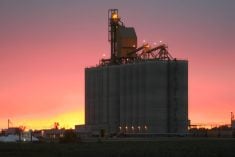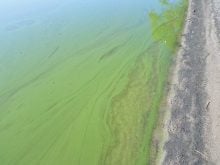NUTRIENT-DENSE SEED
How do you decide what seed to save for planting? Is this an after-the- fact decision, or do you grow a specific variety/seed lot on a specific piece of land, knowing you’ll likely save the seed? It’s a question that had been rattling around in my brain for some time, and so last summer when I was on a farm tour at Terry Aberhart’s farm near Langenburg, Sask., I was excited to learn that he often consciously grows for seed.
Read Also

Cancer agency reclassifies another herbicide ‘probably carcinogenic’
The WHO’s cancer research agency has now put atrazine, a herbicide well known to corn growers, in the same potential-hazard category where the agency put glyphosate.
What does that mean? Well, let’s work through a wheat example (because, of course, it goes without saying that we’re discussing crop types and varieties that can be saved). Terry earmarks his best piece of wheat-growing land for the variety he’d like to multiply, tests the seed, treats it with both a seed treatment and a seed primer, tops up fertilizer rates and usually goes in with a foliar treatment of zinc and other nutrients prior to grain fill. This particular plot of land will also get any fungicide or insecticide treatments necessary, and will be watched closely so as to spray as soon as warranted.
The goal is simple — it’s not about bushels (though that’s nice too), it’s about growing the most nutrient-complete, cleanest, most vigorous seed.
You might think it’s a lot of work for 40 or 160 acres, but consider this — seed lots in Western Canada are chronically lacking in one or more key nutrients. The most heard-about nutrient is zinc (perhaps so heard about you don’t want to hear it), but zinc matters because it plays a key role in the germination process. After a plant is up and growing, zinc isn’t nearly as important, which is why it’s so important that critical levels are present within the seed.
But it’s not just zinc that farmers need to worry about. There are several other micronutrients and even macronutrients that could be low in seed depending on growing conditions, the soil and production management.
Terry offers this cattle analogy that he draws from — which would you rather start with: sickly, underweight calves or strong, healthy calves? It’s a no-brainer in the cattle industry, but because you can’t physically see a difference in nutrient-complete versus nutrient-deficient seed, it’s a tougher sell.
Before you head out the door and start slathering on the fertilizer and seed treatments, however, Terry makes an important point that is the logical first step to determining how you might differently manage seed you plan to save: seed testing. Looking beyond just germ and vigour, you can ask labs to test for nutrient levels in the seed. Tests have confirmed that wheat seed from highly managed fields show increased nutrient levels, higher germ and better vigour.
Angela Lovell has done a great story on the importance of starting with nutrient-complete seed on page 10. Give it a read.
CANOLA SEEDING
I got a call from aGrainewsreader who farms near Swan River, Man. He’s trying to get the most out of his canola crop and had two questions for me: is the canola accessing the phosphate he puts down and can he cut back on seeding rates? He said he seeds hybrid varieties (they use both Liberty-Link and Roundup Ready varieties on their farm) at about five m.p.h. at five pounds per acre. He uses a cultivator- based setup, where the canola goes on with the granular applicator and fertilizer goes down on nine-inch rows, about two to three inches deep. He applies roughly 100 pounds of 30-0-15 per acre each year. Excessive moisture is the norm for this farm in the black soil zone. This farmer is very successful at growing high-quality, high-yielding wheat most years, in the 60-to 70-bushel-an-acre range, but usually ends up somewhere in the 35-to 40-bushel range for canola. He thinks he can do better.
I put the question to Derwyn Hammond, agronomist with the Canola Council of Canada based at Brandon, Man. His thoughts mirrored mine — is seed placement shallow and precise enough for best emergence? The question of whether the canola is reaching the phosphorus is secondary, really, to the actual seed placement.
In moist conditions, such as this farmer has, canola likely only needs to go in a half-inch down. Depending on the opener used (the farmer didn’t say), seeding conditions and seeding speed, this farmer’s canola is likely going down at a range of depths, messing with emergence rates and crop uniformity. In wet conditions and sticky soil, any amount of speed can throw all sorts of soil around, burying the seed much deeper than intended.
Hammond suggests that this farmer start by first determining whether he’s achieving the desired plant-stand count. If he is, how uniformly are the seeds emerging? If plant stand counts are low, the seeding rate could be to blame, but at five pounds an acre is likely not the issue. The opener and seeder setup in conjunction with seeding relatively quickly in wet conditions might be to blame for uneven emergence or low plant-stand counts.
If canola seedlings are emerging uniformly and at a high rate, then it’s time to look at whether or not the fertilizer row is too far from the seed or if phosphorus rates are too low. Hammond says that many farmers don’t realize just how much P is exported off the field in canola seed. Unlike cereals, canola seed itself contains higher levels, relatively speaking, than cereals where P is held in the chaff and straw that is returned. In canola-growing regions, available soil P will start to be limiting if farmers are only providing starter levels.
(Of course, for more on canola seeding, read our cover story by John Mayko.)
SEEDING BY 1,000 KW
Hammond mentions it, but I’ll say it again — do you seed by bushels per acre or by weight? Do you start with a desired plant-count and work backwards or do all your wheat fields get “two bushels an acre” regardless? On the other hand, canola varieties, while usually seeded by pounds per acre, have such variable seed sizes that the actual number of seeds per pound can vary immensely.
I know seeding is a super-busy time (in fact, I once considered changing my May birthday because none of my farming friends could ever make it to my party), but here’s my challenge to you — choose two crops this year that you use a “rule of thumb” to seed by and verify your seeding rate using 1,000-kernel weight and desired plant counts.
Determining 1,000-kernel weight and, in conjunction with desired plant-stand counts, choosing a more accurate seeding rate is not that difficult. In fact, it involves some basic math that could make for an excellent teaching moment for the kids. Measuring out and counting seeds is a great “game” for the kids to play (not to mention most farmers’ least-favourite task in all this), so why not make it their job? Family fun for everyone!
Here’s the formula for finding seeding rate in pounds per acre: Desired plant pop (per square foot) times 1,000 kernel weight, divided by: per cent seed (in decimal form) survival times 10 (so, 90 per cent germ becomes 0.9, then times 10). Remember to adjust per cent seed survival for tough conditions; just because germination is at 90 per cent doesn’t mean 90 per cent of the seeds will become viable plants.
Don’t know desired plant-stand counts? They vary by crop, so I suggest talking to a provincial rep, local agronomist or doing some digging online. The provincial Agriculture Departments have this and much more on their websites. In fact, here’s a link to MAFRI’s site on the topic: www.gov.mb.ca/agriculture/crops/cropproduction/faa03s00.html.
THE OFFICIAL START OF SPRING
As I write this in early March, it’s still bitterly cold (-25 C this morning, ugh). I look at the calendar and can hardly believe it’s nearly “spring.” I’m all for a slow melt, but this is getting a little ridiculous. I hope that by the time you read this the weather is co-operating and you’ve got sunny, mild days to check the seeder, clean up the tractor, top up the coffee mug and get ready for seeding season.
Until next time. Lyndsey














